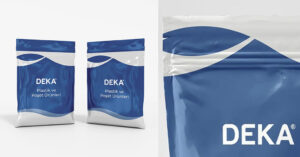The raw materials used in the production of ziplock bags directly affect not only the production cost but also the performance, intended use and durability of the product. Although the right choice between different polymer types such as PE, PP and LDPE will produce results that meet the expectations of the manufacturer and the needs of the users, many factors such as transparency, flexibility, print quality, temperature resistance, chemical compatibility with the content must be taken into consideration when making this choice.
There are many types of ziplock bags available in the market in different sizes, forms and functions, some of which are more concerned with durability, while others are more concerned with visual appeal or suitability for food contact. From zippered packaging systems to printed ziplock bag types, from small ziplock bag models to doypack ziplock bag types, these packaging types have a wide variety and require technical knowledge about which material should be used where.
From the manufacturer’s point of view, preferences such as the zipper structure and the thickness of the bag, which vary according to the intended use, are the main criteria that determine the production process and end-user satisfaction. The material used in models that serve different purposes such as zipper ziplock bags, thick ziplock bags or certified ziplock bags is determined not only by technical reasons but also by the position of the product in the market and the intensity of use.
What is the Material Selection in Ziplock Bag Production?
When deciding which raw material to use in the production process of each ziplock bag model, many features such as the type of product the bag will carry, the usage environment, end-user expectations and the life of the packaging are evaluated together, while technical features such as moisture barrier, heat resistance, flexibility or suitability for printing directly affect the determination of the material to be used.
For example, PE derivatives are preferred in medical sample bags because flexibility and hygiene are more important, while more durable and rigid structures should be used in thick ziplock bags with high carrying capacity. While it is important which certificates materials such as LDPE and PP have in bags that come into contact with food, not only the production cost but also the risks and expectations that the product will carry determine the process. While the choice of material in each ziplock bag production varies according to the intended use and performance expectation, details such as surface smoothness, weldability and compatibility with the zipper system will also make it mandatory to choose the right material.
Differences between PE and PP in Ziplock Bag Selection
Although PE (polyethylene) and PP (polypropylene) materials are the two most commonly used polymer types for ziplock bags, there are noticeable differences between the two. If we briefly look at how important the differences are, PE is generally preferred by the user in zipper ziplock bag models that will be opened and closed frequently by the user because it has a softer and more flexible structure. However, polyethylene is more suitable for frozen products as it is produced with a content that is more resistant to low temperatures.

Polypropylene material is harder, more resistant to high temperatures and has a higher transparency rate than polyethylene. Thanks to this feature, brands that think that their products should stand out on the shelves prefer polyethylene.
Polypropylene surfaces can hold the ink more perfectly and therefore give more perfect results in the production of printed ziplock bags, but this does not mean that PP is advantageous in all cases. For example, since flexibility is more important in small ziplock bags where fragile products will be transported, PE material will be more preferred than PP. Ultimately, the differences between PE and PP are not limited to technical details, but also factors such as area of use, target audience and function will influence the choice between them.
Which Type of Zipper Bags Is LDPE More Suitable for Production?
LDPE (Low-Density Polyethylene) is the most preferred main material for the production of zipper bags, especially because its flexibility and low temperature tolerance allow the bag to be both easily welded and repeatedly opened and closed. LDPE is widely used due to its low risk of chemical interaction with the content it will protect and its high moisture-proof properties.
Although LDPE provides a certain level of clarity in the production of transparent ziplock bags, it does not give as clear an image as PP, but it is better than others in providing a more comfortable experience to the user in terms of tactile sensation and flexibility. With this advantage, it is more preferred in sensitive situations such as sample storage, especially in medical bags or laboratory bags.
In addition to all these features, its low density structure provides a cost advantage when large quantities are produced. Although LDPE is suitable for use in both large ziplock bags and small ziplock bags, double layers or reinforced layers should be preferred, especially in cases where durability needs to be increased.
In which situations is a thick ziplock bag used?
While thin-structured models of ziplock bag types are generally sufficient for light products, thicker, durable ziplock bag types are preferred when heavy or cutting products are to be transported. In this case, in the production of thick ziplock bags, the production stage is finalized in line with the physical load the bag will be exposed to and user expectations.
The thickness of a bag is not only measured in millimeters, but also in terms of flexibility, layer structure and compatibility with the zipper system. For example: bags for transporting metal parts, construction materials or products containing liquids are usually made of materials with a higher micron value. LDPE is suitable for such applications, but sometimes HDPE or reinforcement layers can be added to make it more resistant. In zipper-lock bag structures, the thickness is directly related to the strength of the zipper system, as the zipper placed in the weak material can wear out in a short time, and the correct choice of thickness is decisive in terms of both user satisfaction and product safety.
What Are Considered in Printed Ziplock Bag Production?
Since not every plastic surface will retain the ink correctly, we can say that the visual quality in the production of printed ziplock bags is directly related to the material used. While Polyethylene structures tend to disperse a little more in printing applications, the use of Polypropylene is more common in branded or promotional product packaging, as harder surfaces such as Polypropylene preserve clear lines and allow vibrant colors to emerge.
However, print quality is not only related to the material, the surface texture of the bag, the lining material applied before printing, drying time and the printing technique used are effective factors. For example, a doypack ziplock bag with a multi-colored logo or a detailed design is one of the models that require high print clarity, so it is expected that the print will both look smooth and not be erased over time. In other words, in models like this, the material should be able to carry the print well instead of resisting it.
Whatever the type, size and visual content of the print, it is known that without the right choice of material, the desired result cannot be achieved, so some manufacturers use PE and PP laminated to ensure print quality is not compromised, and this method provides complete flexibility and print clarity.
Different Raw Material Use for Small and Large Ziplock Bag
Although it may seem that bags of different sizes can be produced with the same material, the expectations for the end use affect the production process. Since small ziplock bag models are generally used for light and sensitive jobs such as sample storage, jewelry packaging, medical product transportation, flexibility, lightness and food contact suitability are the primary criteria for these models. LDPE is economical thanks to its thin structure and has the structure to meet this need due to its easy processing.
On the other hand, although PE-based materials are preferred in the production of large ziplock bag models, sometimes double-layer systems or polymer blends are used. This difference becomes more evident especially in bags intended for warehouse, industrial or outdoor use, and at the same time, since the area to be held by the zipper system is wider in these types, the weldability feature suitable for this structure is among the must-haves.
Since the material’s welding temperature, printing type and the stresses it will face during transportation are also recalculated according to the size, the same production formula is not used for each bag, small or large, and each manufacturer has to re-select the material according to the intended use.
Material Compatibility Check in Certified Ziplock Bag Production
Certified ziplock bag production is not only limited to the production line, as it is carried out according to certain standards from the raw material supply. For a product that will come into contact with food, sustainability criteria such as compliance with FDA or European regulations, recyclability, carbon footprint and environmental friendliness must also be taken into account in production.
Each material used at this stage must have a specific quality certificate and these documents must be included in the production file. In particular because the producer has to set up a system where he can trace which supplier the raw material came from, with which batch number it was processed and which tests it has undergone ziplock plastic bag Raw materials such as PE, PP and LDPE used in production are analyzed and documented through analyses such as chemical content, heat resistance and migration tests.
In addition, at the final product stage, quality control is carried out by testing criteria such as light transmittance, zipper strength, welding line strength in ziplock transparent bag models. Since these bags, which are special for specific purposes, have to pass national and international audits, the production of certified ziplock bags requires not only good material selection but also a systematic traceability and control process.


